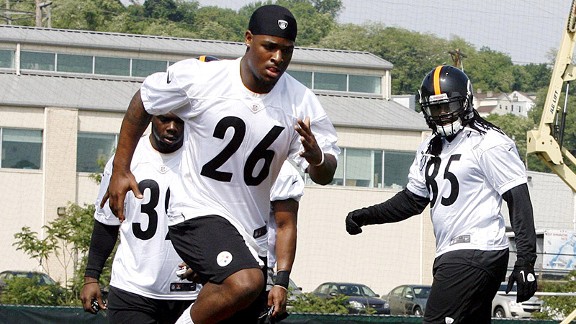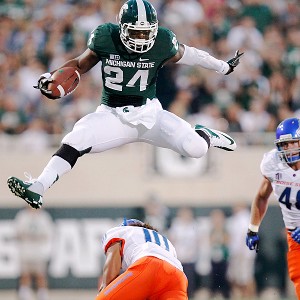By Jamison Hensley | ESPN.com
http://espn.go.com/blog/afcnorth
June 27, 2013
 Charles LeClaire/USA TODAY SportsLe'Veon Bell is being counted on to help re-establish the Pittsburgh Steelers' running game.
Charles LeClaire/USA TODAY SportsLe'Veon Bell is being counted on to help re-establish the Pittsburgh Steelers' running game.And Bell wasn't the first running back selected in the draft. The Cincinnati Bengals choseGiovani Bernard 11 spots ahead of Bell in the second round.
But when it comes to importance and immediate impact, no one ranks ahead of Bell. The big, elusive Michigan State runner is the leading candidate to get the Steelers' once proud rushing attack back on track. He's their best hope to bring back big plays to the ground game. He's also the key to turning the Steelers into a playoff team again.
Pittsburgh needs Bell to be more than a starter. It needs him to be a finisher. An offensive coordinator once told me that throwing the ball scores points, but running it wins games. Teams need to be able to grind out yards and the clock to close out games, something the Steelers were unable to do last season.
According to ESPN Stats & Information, Pittsburgh ranked 25th in the NFL in fourth-quarter rushing yards. How important is that? The nine teams that struggled the most running the ball in the fourth quarter all missed the playoffs. Four of the top five teams in fourth-quarter rushing last season made the playoffs.
Le'Veon Bell After Contact
 Le'Veon Bell gained 921 yards after contact in 2012, most among players from AQ schools. Bell gained more than 50 percent of his yards after contact and averaged 2.4 yards after contact per rush.
Le'Veon Bell gained 921 yards after contact in 2012, most among players from AQ schools. Bell gained more than 50 percent of his yards after contact and averaged 2.4 yards after contact per rush.| Running back | School | YAC |
|---|---|---|
| Le'Veon Bell | Michigan State | 921 |
| Montee Ball | Wisconsin | 887 |
| Ka'Deem Carey | Arizona | 885 |
| Johnathan Franklin | UCLA | 765 |
| Source: ESPN Stats & Information | ||
This is why Bell looks like a great fit for Pittsburgh. He was college football's ultimate workhorse last season. No one had more than Bell's 382 carries, and only one other back had more than 356 carries. The watershed moment of his career came against Boise State last year, when he touched the ball 50 times for 265 total yards in a 17-13 comeback victory.
Bell wants to run the ball on first down. He wants to catch it on third down. He wants the ball as much in the final quarter as the first.
"In the fourth quarter, that’s grind time," Bell said at the team's mandatory minicamp earlier this month. "That’s when you have to bring it home. That’s when you know your team is going to look to you to make plays, and that’s something you look forward to. You have to take pride in that and get the job done."
Bell hasn't been named the starting running back, but it would be a surprise to see anyone else lining up behind Roethlisberger when the Steelers kick off their season against theTennessee Titans, even though recent history is against Bell. The last rookie to lead the Steelers in rushing was Tim Worley in 1989, three years before Bell was born.
The Steelers can call it a competition at running back, but Pittsburgh will have trouble running the ball if Bell doesn't step up immediately. The Steelers are coming off their second-worst rushing season (1,537 yards) since the NFL went to a 16-game schedule in 1978. General manager Kevin Colbert didn't hide his dissatisfaction, saying at the NFL combine in February, "Where we were in the running game last year was indicative of the talent at the position.”
Rashard Mendenhall wasn't re-signed. Jonathan Dwyer was reportedly shopped around after Bell was drafted. And Isaac Redman has proved to be nothing more than a backup.
[+] Enlarge

Gregory Shamus/Getty ImagesLe'Veon Bell's versatility was appealing to the Steelers.
Some may wonder why the Steelers waited until the second round to draft Bell when he's so valuable to this season and the future. Part of it goes back to the devaluation of running backs in general because they have shorter careers. Teams also had questions about this running back class in particular.
There are durability concerns about Bernard and Eddie Lacy. There are doubts about Montee Ball's top-end speed. Bell has to prove he can run between the tackles, show he can pass protect and change his upright running style, which makes him -- at 6-foot-1 -- too big of a target.
What separates Bell from those other backs taken in the second round is his supporting cast. Bernard, Ball and Lacy all had linemen blocking for them who were drafted in the first round this year. Bell didn't have the luxury of open holes, which is why he led the nation with 921 yards after contact last season.
“It was pretty clear that this was the guy that we would be most excited about being available when it came to our pick,” offensive coordinator Todd Haley said after the Steelers drafted Bell.
There's a common misconception about Bell because of his size. Former Steelers running back Jerome Bettis welcomed Bell on Twitter by writing: "The steel city loves big backs!!" Bell is 244 pounds, but he doesn't consider himself a bruising back. He has more finesse in his game. He likes to get outside and has been known to hurdle tacklers in the open field.
Bell isn't trying to be the next Bettis, but he is quite familiar with the success of the Steelers' running game in the past and wants it to reach that level once again.
"Growing up, my family was hard-core Pittsburgh Steelers fans. I know the Steelers love revolving their offense around the running game," said Bell, who grew up in Columbus, Ohio. "The fact that they picked me made me very happy. I’m glad where I’m at, and I want to go out there and make plays for them.
"
No comments:
Post a Comment